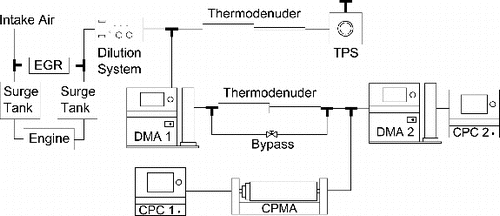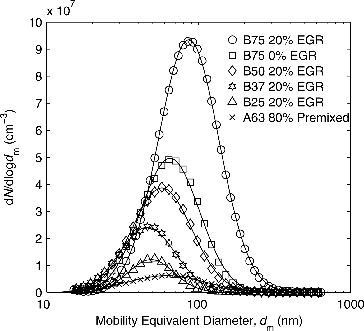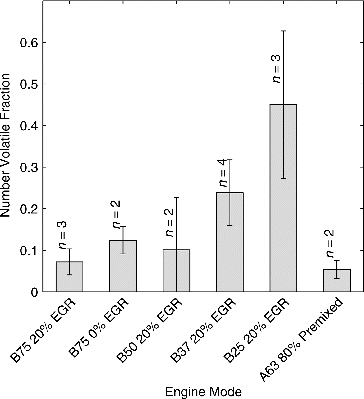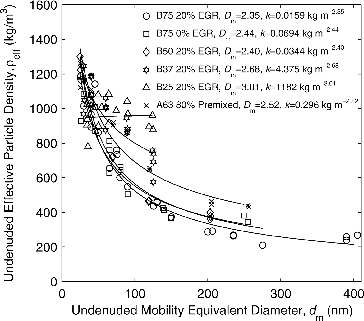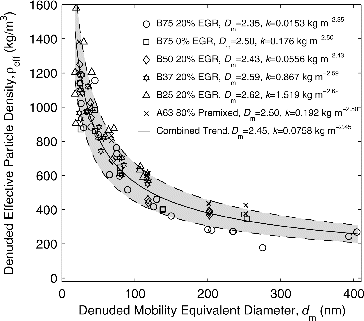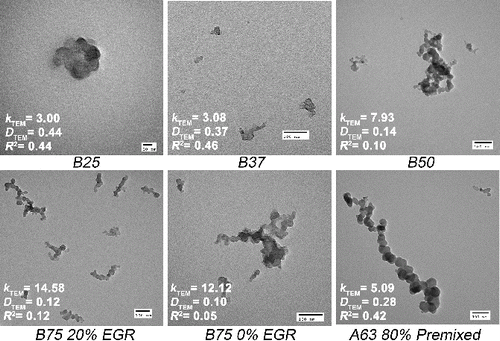Abstract
The particulate matter (PM) emitted from a single-cylinder compression-ignition, natural-gas engine fitted with a High-Pressure Direct-Injection (HPDI) system distinctly different from a duel fuel engine was investigated, and characterized by size distribution, morphology, mass-mobility exponent, effective density, volatility, mixing state, and primary particle size using transmission electron microscopy (TEM), and tandem measurements from differential mobility analyzers (DMA) and a centrifugal particle mass analyzer (CPMA). Six engine conditions were selected with varying load, speed, exhaust gas recirculation (EGR) fraction, and fuel delivery strategy. An increase in engine load increased both the number concentration and the geometric mean diameter of the particulate. The fraction of the number of purely volatile particles to total number of particles (number volatile fraction, NVF) was found to decrease as load increased, although at the lower speed, partially premixed mode, the lowest NVF. All size distributions were also found to be unimodal. The size-segregated ratio of the mass of internally mixed volatile material to total particle mass (mass volatile fraction, MVF) decreased with load and with particle mobility-equivalent diameter. A roughly constant amount of volatile material is likely produced at each engine mode, and the decrease in MVF is due to the increase in PM number with load. Effective density and mass-mobility exponent of the non-volatile soot at the different engine loads were the same or slightly higher than soot from traditional diesel engines. Denuded effective density trends were observed to collapse to approximately the same line, although engine modes with higher MVFs had slightly higher effective densities suggesting that the soot structures have collapsed into more dense shapes—a suspicion that is confirmed with TEM images. TEM results also indicated that primary particle size first decreases from low to medium load, then increases from medium to high load. An increase in EGR was also seen to increase primary particle size. Coefficients were determined for a relation that gives primary particle diameter as a function of projected area equivalent diameter. A decrease in load or speed results in a stronger correlation.
Copyright 2015 American Association for Aerosol Research
INTRODUCTION
Despite the many benefits of compression-ignition engines, they tend to produce a large amount of particulate matter (PM) in comparison to spark ignition engines. The PM can have adverse effects on the environment and human health, and as a result, emissions regulations are becoming increasingly stringent (Johnson Citation2012). While the combustion of natural gas tends to produce a lower amount of PM than diesel fuel, it is still important to understand these emissions, both quantitatively and qualitatively. The nature of the particles emitted may dictate the type of exhaust after-treatment that is used on natural-gas compression-ignition engines.
The High-Pressure Direct-Injection (HPDI) system uses natural gas and diesel fuel at pressures up to 300 bar. Both fuels are introduced using concentric passages with separate holes on the same injector. Near top dead center (TDC), the diesel pilot is injected (approximately 5% of the total energy), and autoignites. The natural gas is then ignited by the diesel pilot flame. The natural gas combustion is predominately unmixed, which helps avoid knock and allows for a high-compression ratio and thermal efficiency, like those associated with diesel engines (McTaggart-Cowan et al. Citation2012). In this engine, soot particles are mainly formed by incomplete combustion of natural gas (Jones Citation2004). Strategies to reduce PM (reviewed below) resemble those used for conventional diesel engines. In contrast, “dual-fuel” or “fumigated” engines use late-cycle diesel injections (Wong et al. Citation1991; Mustafi et al. Citation2010) to ignite natural gas that is mixed with the intake air. In fumigated engines, soot emissions are almost entirely due to the diesel fuel, while the premixed charge gives rise to NOx, CO, and HC emissions resembling those of spark-ignited engines. Because the HPDI system allows independent control of the gas and diesel injections, it is possible to inject the gas earlier than the diesel pilot, producing conditions that are closer to the fumigated natural-gas engine. One of these conditions is included in the experiments described in this article.
Several studies have already been conducted on this single-cylinder research engine (SCRE) equipped with an HPDI fuel system. Patychuk and Rogak (Citation2012) studied the PM mass, size, and composition while varying equivalence ratio (EQR), gas rail pressure (GRP), exhaust gas recirculation (EGR), injection timing, and diesel injection mass for a mid-speed (1500 RPM), high load (16.5 bar gross indicated mean effective pressure [GIMEP]) engine condition. They determined that PM mass emissions were affected primarily by EGR and EQR, and PM number emissions were also affected by EGR and EQR, and less strongly by GRP and diesel pilot quantity.
McTaggart-Cowan et al. (Citation2012) worked to reduce the PM mass emissions for the same engine mode used by Patychuk and Rogak (Citation2012). They found that PM could be reduced by adjusting the relative phasing of the diesel and natural gas injections to allow for more premixing of the natural gas with air. In addition, a reduction in pilot mass to increase ignition delay and lower EGR levels also helped. These conditions were also found to reduce CO, but increased the levels of unburned hydrocarbons and NOx. The reduction in pilot injection mass significantly reduced PM for a given NOx level at high load, although not much effect was seen at low load. They determined that optimized conditions give a large reduction in PM while sacrificing some NOx emissions. A smaller improvement in PM emissions is possible with no NOx cost.
Faghani et al. (Citation2013) also investigated methods of reducing PM levels from this engine. They determined that a split gas injection strategy where 15–20% of the natural gas is injected 1.5–2.5 ms after the end of the first injection can reduce PM and CO emissions by 80%. Methane emissions were also reduced, NOx did not seen to be affected, and fuel consumption increased marginally (∼1%).
Patychuk (Citation2013) observed the effects of engine speed and load, injection timing, EQR, EGR, GRP, diesel injection mass, and amount of fuel premixing (fuel premixing is where some of the natural gas is injected into the cylinder before the diesel pilot and given time to mix before ignition) on the morphology of the PM emissions. An increase in engine load increased particle mass and number concentrations. Engine speed showed the same trends, although a weaker relationship was seen. Mean particle size also increased with load, and mass and number volatile fractions (MVF and NVF) decreased. At single mode operation, EQR, variations in GIMEP, and GRP had the largest bearing on PM mass emissions. Overall, primary particle size exhibited a weak negative correlation with speed, although there was a positive correlation for mid and high loads between the low and mid speeds (1200 RPM and 1500 RPM). Primary particle size was also seen to correlate positively with aggregate size (Dastanpour and Rogak Citation2014).
For these experiments, we studied the PM morphology and volatility in more detail through size-segregated particle mass, measured using a centrifugal particle mass analyzer (CPMA), and through transmission electron microscopy (TEM). The CPMA classifies particles based on mass-to-charge ratio (Olfert and Collings Citation2005). The CPMA (or a related instrument, the aerosol particle mass analyzer, APM) has been used to measure the mass-mobility relationship of particles emitted from several engines including: diesel engines (Park et al. Citation2003; Olfert et al. Citation2007; Barone et al. Citation2011), natural-gas-fueled homogenous-compressed charge-ignition engines (Bullock and Olfert Citation2014), and aircraft turbines (Durdina et al. Citation2014; Johnson et al. Citation2015).
TEM is a commonly accepted ex-situ method for direct characterization of the soot morphology (Medalia and Heckman Citation1969; Rogak et al. Citation1993; Brasil et al. Citation1999; Dastanpour and Rogak Citation2014; Seong et al. Citation2014). Primary particle diameter, aggregate maximum length and width, projected area equivalent diameter, and gyration radius can be measured from these images. Three-dimensional morphology parameters, e.g., number of the primary particles in individual particles, can be inferred from these two-dimensional parameters (Rogak et al. Citation1993; Brasil et al. Citation1999; Park et al. Citation2004; Tian et al. Citation2007).
In this article, a CPMA, TEM, and tandem differential mobility analyzers are used to thoroughly characterize the PM emissions in terms of their size distributions, morphology, mass-mobility exponents, effective densities, volatility, mixing state, and primary particle size. This work analyzes these characteristics both in absolute terms and in relation to aggregate size. Knowledge of the particle volatility (NVF, MVF, and mixing state) is useful for choosing suitable exhaust after-treatment (e.g., oxidation catalyst or particulate filters). Furthermore, an understanding of the mass-mobility relationship allows the PM mass concentration to be calculated from size distribution measurements instead of filter methods that are time consuming and susceptible to measurement artifacts, especially at low particle concentrations (Liu et al. 2012). Moreover, knowledge of the PM morphology can help distinguish any differences between natural-gas HPDI soot and diesel soot observed with light scattering or other optical techniques.
EXPERIMENTAL SETUP
The experimental configuration is displayed in . This work was conducted on a single-cylinder engine located in the University of British Columbia's Clean Energy Research Centre. The engine specifications are outlined in Table S1 of the online supplementary information. The engine is a six-cylinder Cummins ISX engine modified so that only a single cylinder fires using an HPDI injector. Further information on the engine is reported by McTaggart-Cowan et al. (Citation2007) and Patychuk (Citation2013). This single-cylinder engine uses a prototype fueling system, and the operating conditions and results, while generally representative of non-premixed natural gas combustion, do not relate directly to any previous, current, or future Westport engines. The testing was performed at six different operating conditions, which were based on the European Stationary Cycle (ESC-13; EU Citation1999). The ESC-13 modes are a common starting point when determining relevant operating conditions for heavy-duty engines (McTaggart-Cowan et al. Citation2012). Engine modes were selected at 25%, 37%, 50%, and 75% of maximum load at an engine speed of 1500 RPM (denoted B25, B37, B50, and B75 corresponding to 5.5, 8.25, 11, and 16.5 bar GIMEP). These modes operated with 20% EGR; however, at the highest load a 0% EGR mode was also examined.
A lower speed of 1200 RPM at 63% maximum load and 0% EGR (denoted A63) was also tested. At this mode, the majority (∼80%) of the natural gas was injected into the combustion chamber during the intake stroke, allowing the bulk of the gas to premix before ignition. A diesel pilot was used near TDC to initiate the combustion event. This mode was selected as it provided relatively low total PM emission (on a mass basis) due to the premixed nature of the combustion. As such, it was hypothesized that the characteristics of the PM formed at this mode would be very different from that at other modes.
For PM sampling, the exhaust gas was first passed through a two-stage ejector dilutor system with an overall dilution ratio of approximately 11:1. Flow was then split into two streams, one of which fed a series of instruments to quantify the particles’ mass-mobility relationship, volatility, and the mixing state of the volatile material. The particles first passed into a differential mobility analyzer (DMA1; Model 3081, TSI Inc., Shoreview, MN, USA) set at a constant voltage to admit a constant, narrow range of particles with the same electrical mobility. DMA1 was operated with a sheath flow of 6 L/min and aerosol flowrate of 0.6 L/min. The aerosol flow then proceeded through either a thermodenuder or its bypass, after which the flow was split again. Half of this flow was sent to an SMPS system consisting of a second DMA (DMA2) with a sheath flow of 3 L/min and a condensation particle counter (CPC, Model 3775, TSI Inc., Shoreview, MN, USA) with an aerosol flow of 0.3 L/min. Because the particles had already been sent through the first DMA, the second DMA's charger was bypassed. The second DMA progressively stepped through the particle size range, while the CPC recorded the corresponding number concentration. The mobility-equivalent diameter was taken to be the geometric mean diameter (GMD) of a lognormal fit of the data. For an undenuded sample, a mean bias of 0.5% was observed between the first DMA's mobility-equivalent diameter set point and the GMD reported by the second DMA. Total particle distributions were also measured by bypassing the first DMA and performing SMPS scans on the entire particle sample. Number concentrations for denuded scans were corrected for diffusional deposition losses through the thermodenuder using the formulation in Gormley and Kennedy (Citation1949). The losses are a function of a single dimensionless parameter proportional to tube length, volumetric flowrate, and the particles’ diffusion coefficient. Tube length was taken to be the additional length of tube in the denuder, compared to the flow path of the undenuded samples. Particles are also lost due to thermophoresis in the thermodenuder. Experimentally, it was determined that the thermophoretic losses were relatively small (∼5–10%). A correction for thermophoretic losses was not applied to the data as it was found (in some cases) to overcompensate the losses (the corrected denuded number concentrations were higher than the undenuded samples).
The remaining half of the aerosol exiting the thermodenuder was sent to a CPMA, which classifies particles based on their mass-to-charge ratio (Olfert and Collings Citation2005). The CPMA was stepped through various particle mass settings, by stepping both the rotation speed and voltage to ensure a constant resolution across the CPMA range. The resolution, defined as the inverse of the normalized full-width half-maximum of the transfer function, was approximately 10 (i.e., the resolution was approximately a tenth of the CPMA set point). Particle counts at these mass settings were measured using a CPC (Model 3025, TSI Inc., Shoreview, MN, USA). Under the assumptions that there are no multiply charged particles and that the effective density is approximately constant for a given mobility (reasonable for the narrow range of classified particles), the distribution function is normal and the peak is equivalent to the average particle mass classified by the CPMA. If multiply charged particles are present, they may be seen as a second concentration peak, given that the CPMA and DMA resolutions are high enough. A least-squares minimization can be performed that fits the data with a lognormal distribution (or bi-modal lognormal distribution if multiple charged particles are present), as seen in Tajima et al. (Citation2011).
The second line from the diluter leads to the thermophoretic sampler (TPS), which deposits particles onto carbon grids (300 Mesh Cu) using thermophoretic deposition for TEM analysis. The samples were collected downstream of the upper thermodenuder in operating at 200°C to remove the semi-volatile material. On average, 40 images were produced for each test point using a Hitachi H7600 transmission electron microscope operating at 80 kV under high-resolution mode. Images were taken at the center and four other locations around the grid. Images considered in size characterization were collected at optimum optical focus with nominal resolution of 0.2 nm. Morphology parameters of soot particles were extracted from TEM images using a semi-automated image-processing program written in MATLAB (see the supplemental information of Dastanpour and Rogak Citation2014).
EXPERIMENTAL RESULTS
Size Distributions
The undenuded size distributions for all engine modes can be seen in . A clear trend is observed whereby an increase in engine load produces a higher PM number concentration, as well as a larger GMD. Mode A63 80% Premixed was seen to have the broadest distribution, in addition to the lowest number concentration. Its GMD also followed the relationship with load: found between mode B50 20% EGR and the B75 modes.
Volatility and Mixing State
SMPS scans of denuded particles were also performed for each engine mode. highlights the comparison between denuded and undenuded scans for mode B25 20% EGR. The change in GMD is related to the amount of internal mixing between semi-volatile liquids and solid fractal-like carbonaceous particles. Internal mixing implies that both species are present on a single particle (a solid elemental carbon particle coated with liquid volatile material). As such, the particle diameter will decrease once it is denuded. Also, the reduction in total number concentration is indicative of externally mixed volatility—semi-volatile droplets are mixed separately from the soot particles (i.e., some semi-volatile droplets contain no soot). Denuding this type of mixed aerosol will eliminate all particles comprised solely of semi-volatile material.
FIG. 3. Denuded and undenuded particle number concentration for mode B25 20% EGR, corrected by dilution ratio of 11:1.
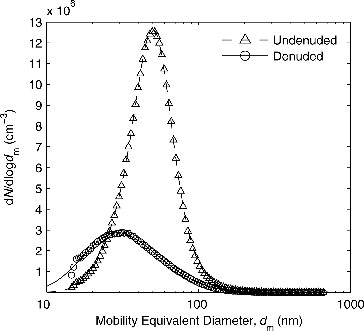
The amount of external mixing can be quantified using the NVF. The NVF of a particle distribution is equal to the number of purely volatile particles that are removed by denuding, divided by the total number of nascent particles (the total number concentration measured by the SMPS). The NVFs for each engine mode are compared in , along with the number of times each mode was reproduced. An increase in engine load results in a smaller NVF, whereas the decrease in EGR at condition B75 resulted in an increase in NVF. Finally, the lower-speed, fumigation-style mode A63 80% Premixed contained the lowest NVF of all.
In diesel-fueled compression-ignition engines, the externally mixed semi-volatile particles are generally thought to be contained in the nucleation mode—a mode of the size distribution generally below 50 nm in diameter and readily distinguished from the accumulation mode comprised of internally mixed soot particles of larger size (Kittelson Citation1998). In contrast, the particles emitted from the HDPI engine contain significant numbers of externally mixed semi-volatile particles (), yet the size distributions are all unimodal (). Although these particles are generated by very different processes (e.g., nucleation vs. agglomeration of soot followed by condensational growth), these modes are not distinguishable in the undendued size distribution. This is because when the number fraction of externally mixed particles is large, the size of the soot particles is relatively small (e.g., B25 20% EGR), and when the size of the soot particles is relatively large, the number fraction of externally mixed particles is relatively low (e.g., B75 20% EGR).
In addition to quantifying volatility on a number basis, more information on the PM mixing state can be gained from presenting the volatility on a mass basis. The MVF within a single particle (internally mixed volatility) is defined as the mass of volatile material condensed on a particle (denuded mass subtracted from undenuded mass) divided by the total (undenuded) mass of the internally mixed particle. The MVFs as a function of particle size are plotted in . Error bars represent one standard deviation, and included in the legend are the number of times each mode was reproduced. Almost all of the uncertainty in these results stem from the low reproducibility of the engine modes and the variability in volatility rather than inaccuracies in the instruments. The same engine conditions on a different day can yield different levels of volatility. This can be due to factors such as variation within the engine itself or the dilution system causing changes in particulate composition. The highly volatile modes are more susceptible to this variation.
FIG. 5. Mass volatile fraction of exhaust particles. Error bars represent one standard deviation. Mode B50 20% EGR at 250 nm was reproduced n = 3 times, and mode B25 20% EGR was reproduced n = 2 times at 50 nm, n = 3 times at 35 and 125 nm, and n = 4 times at 65 and 90 nm.

The high-load modes such as B75 20% EGR, B75 0% EGR, and B50 20% EGR showed low amounts of internally mixed volatile matter. In comparison to mode B75 20% EGR, the 0% EGR case had an MVF that was several percentage points higher. As load decreased however, the MVF increased, as with modes B37 20% EGR and B25 20% EGR. Volatile material may be partially derived from lubricating oil (which would produce approximately the same amount of volatile material independent of load), yet the MVF decrease may be due to the larger number concentration of aggregate particles at high loads. The MVF of mode A63 80% Premixed was found to be between the high-load modes and B37 20% EGR, at around 20%. The decreasing trend in volatility as mobility-equivalent diameter increases has also been observed for diesel exhaust (Sakurai et al. Citation2003; Ristimäki et al. Citation2007), as well as McKenna and inverted burners (Ghazi et al. Citation2013).
Effective Density
The mass of a particle (m) is often found to scale with mobility-equivalent diameter () in a power-law relationship,
[1] where
is a prefactor, and
is the mass-mobility exponent. This formula can then be used to determine the effective density of the particles,
[2]
Because aggregate particles typically incorporate more open space as they grow, their effective density tends to decrease as size increases. The prefactor and exponent
are determined by fitting a power-law relation through several corresponding masses and mobility-equivalent sizes throughout the particle size distribution.
Effective density measurements for all engine modes, without denuding the particles, can be seen in , with the prefactors and mass-mobility exponents listed in the legend. The B75 modes and mode B50 20% EGR possess similar trends, having mass-mobility exponents of about 2.4. Modes A63 80% Premixed and B37 20% EGR have larger mass-mobility exponents and effective densities. Mode B25 20% EGR has a mass-mobility exponent of approximately 3, meaning that the particles are spherical, and hence their effective density does not change with size. As discussed above, the externally mixed volatile modes B25 20% EGR and B37 20% EGR would normally be expected to show two concentration peaks in the CPMA scans; however, this was not observed. Therefore, the effective densities of the aggregate particles and the volatile droplets must be similar. The density of engine oil or similar hydrocarbon liquid is usually between 800 and 1000 kg/m3. If the aggregate effective density is close to this range, a single concentration peak should be observed despite the fact that two particle species are present.
Denuded effective density data is plotted in , with the prefactors and mass-mobility exponents shown in the legend. The majority of the data collapses to mass-mobility exponents of 2.4 to 2.6. Despite the different mass-mobility exponents, the denuded effective density data is still somewhat grouped, and so it may be convenient to represent all modes with a single relationship for mass concentration calculations via SMPS scans. This can also be seen in . Data points are plotted using the denuded mobility-equivalent diameter measured with the second DMA, after volatile material was removed. The shaded region represents an uncertainty of ± 20% in effective density. The effective density data for diesel soot from Olfert et al. (Citation2007), as well as that from Maricq and Xu (Citation2004), are within the region of uncertainty of the combined trendline throughout the given size range; however, the effective densities determined by Park et al. (Citation2003) were found to be higher for mobility equivalent sizes below 220 nm. In comparison to these previous diesel studies, the mass-mobility exponents determined here are similar or slightly higher. For reference, Park et al. (Citation2003) found exponents of between 2.33 and 2.41, Maricq and Xu (Citation2004) had exponents of 2.3 ± 0.1, and Olfert et al. (Citation2007) had mass-mobility exponents of 2.22 to 2.48 when the volatility was low. It is interesting to note that although natural gas reduces the PM number and mass concentrations in relation to diesel, the morphology of the soot remains quite similar.
A comparison of to elucidates that there was in fact some volatile material coating the particles that was subsequently evaporated inside the thermodenuder. This conclusion agrees well with the above-mentioned volatility results: low-load modes such as B25 20% EGR and B37 20% EGR contained the highest levels of volatile matter. The spherical particles observed at undenuded mode B25 20% EGR are likely coated with (or entirely comprised of) liquid material, and fittingly, the observed density is similar to that of engine oil or liquid hydrocarbon. The intermediate exponents of modes A63 80% Premixed and B37 20% EGR likely also result from the presence of volatile material; however, in these cases, the amount present is not sufficient to form a sphere around the soot structure, as with B25 20% EGR.
Morphology, Mass-Mobility Exponent, and Primary Particle Diameter
Sample TEM images of the test points are shown in . Image processing results are also summarized in Table S2. TEM images demonstrated the collapse (or restructuring) of some soot aggregates at the high-volatility engine mode (mode B25 20% EGR). The restructuring of soot into more compact clusters when volatile material is condensed on them is reported in the literature (Slowik et al. Citation2007). This is also consistent with , which shows the effective densities of denuded B25 20% EGR particles tend to be higher (especially at higher mobility diameters) than the densities from other engine modes. The slightly elevated effective densities seen in Modes B37 20% EGR and A63 80% Premixed suggest that this effect may be present there as well. The degree to which the aggregate is restructured is dependent on the amount of volatile material coating the particle, as shown by Ghazi and Olfert (Citation2013). This effect is noticeable for the more volatile engine modes with elevated internally mixed MVFs because the amount of material coating the particle is sufficient to cause the soot to collapse. Note that the DMA-CPMA system will show this collapse in particle structure for a given mode even if the majority of particles (but not all) have collapsed, because their measurements are number-based. Alternatively, effective density has also been shown to scale with primary particle diameter (see below).
TEM results show that the primary particle diameter (dp) first reduces when load increases from low to medium and then increases again from medium to high load conditions. For all operating conditions, the standard deviations of the primary particle size distributions are approximately 35% of the average primary particle diameter. Primary particle diameter is affected by different parameters including local EQR, temperature, and residence time of the particles in the combustion region (Glassman Citation1989; Park et al. Citation2005). The reduction observed in primary particle diameter when load increased from low to high levels may attribute to faster carbonization and higher oxidation rates due to higher temperature. Further increases in load result in higher EQRs in the combustion chamber. This may ultimately shift the balance between formation and oxidation rates and result in the formation of larger primary particles.
TEM results also show that the EGR results in an increase in primary particle diameter from 18.6 nm at 0% EGR to 25.7 nm at 20% EGR. This contrasts with previous findings by Patychuk (Citation2013) where EGR had no effect on primary particle diameter. However, this agrees with the presence of a correlation between aggregate and primary particle diameters (Dastanpour and Rogak Citation2014).
Primary particle diameter highly depends on engine operating condition. The average diameter of the primary particles varies between 13 nm and 26 nm in this study. Changing the engine operating conditions, Patychuk (Citation2013) has measured primary particle diameter in the range of 23 to 33 nm for the same engine. The range of primary particle diameters measured on the HPDI engine (13–33 nm) is similar to the measurements of primary particle diameter in diesel engines (Lee et al. Citation2002; Wentzel et al. Citation2003; Park et al. Citation2004; Zhu et al. Citation2005; Neer and Koylu Citation2006). Combining results obtained in this study with those reported by Mabson (Citation2015) for the same engine, mean gyration radius of soot aggregates varies between 25 nm and 87 nm for the HPDI engine considered here. This is considerably smaller than the results reported for diesel engines, 75–180 nm (Lee et al. Citation2002; Zhu et al. Citation2005; Neer and Koylu Citation2006). Previous studies conducted on the same HPDI engine (Soewono Citation2008; Mabson Citation2015) showed the fractal dimension and prefactor of the soot particles to be in the range of 1.4 to 1.8 and 1.43 to 2.53, respectively. Measured fractal dimensions and prefactors are approximately consistent with the range of 1.46 to 1.88, and 1.3 to 4.0 reported for diesel engines, respectively (Lee et al. Citation2002; Wentzel et al. Citation2003; Park et al. Citation2004; Zhu et al. Citation2005; Neer and Koylu Citation2006). However, a precise comparison of the fractal prefactors is difficult because of differences in the methods used.
Dastanpour and Rogak (Citation2014) have discussed the presence of a correlation between primary particle size and aggregate size. This correlation can be explained if soot aggregates are formed in homogenous microscopic regions, and aggregates with different formation and growth patterns are mixed. Their database comprised of four different soot sources including 14 different operating conditions of the HPDI engine considered in this study. They reported a correlation for the primary particle diameter as a function of projected area equivalent diameter of aggregates in the form of , where
= 6.49 (5.46, 7.52),
= 0.29 (0.26, 0.32), and R2 = 0.327 (values in parenthesis are 95% confidence intervals) for the HPDI engine considered here. The fit parameters (
,
, R2) obtained for the individual operating conditions considered in this study are shown inset to (details on the TEM analysis are given in Table S2). As shown in the figure, decreasing load or speed results in stronger correlations (larger
) between the primary particle and aggregate sizes. This trend might be an indication of more (relatively) heterogeneous charge distribution and lower mixing rates of the soot particles at lower engine loads and speeds, respectively.
CONCLUSION
The characteristics of the particulate emitted from a single-cylinder, compression-ignition, natural-gas research engine fitted with an HPDI system were studied in terms of their size distributions, morphology, mass-mobility exponents, effective densities, volatility, mixing state, and primary particle diameter. Number concentration and GMD were seen to increase with engine load. The NVF decreased as load increased, although mode A63 80% Premixed had the lowest NVF (but is a very different combustion regime). MVF also decreased with load, and A63 80% Premixed had an MVF between that of B37 20% EGR and the higher-load modes. It is speculated that a roughly constant amount of volatile material is produced at each engine mode, and the decrease in MVF is due to the increase in PM number with load. The MVF was also seen to decrease as mobility-equivalent diameter increased.
The effective density and mass-mobility exponent results also indicate that more volatile material is present for the low-load modes, especially for mode B25 20% EGR where the undenuded particles are spherical and are likely entirely coated with volatile liquid. Denuded effective density trends were observed to collapse to within approximately 20% of a line of best fit. This single effective density function could be used to calculate particle mass concentrations for denuded PM using particle number distributions (Liu et al. 2012). However, the effective densities of undenuded soot were highly variable with respect to load due to the presence of relatively high amounts of volatile material at low load. Therefore, load-dependent effective density functions would be needed to calculate mass concentrations for undenuded particulate.
Although denuded effective densities were relatively similar with respect to load, it was observed the effective densities of modes with high levels of volatility were slightly higher, which suggests the soot structures collapsed into slightly more compact shapes. This was supported by TEM images of mode B25 20% EGR. TEM results also revealed that primary particle size reduces when load increases from low to medium and then increases again from medium to high load. This non-monotonic trend may be due to competing effects from the higher temperatures achieved from the initial load increase, and the higher EQRs seen at even higher loads. An increase in EGR was also seen to increase primary particle size.
Finally, coefficients were determined for a relation that gives primary particle diameter as a function of projected area equivalent diameter. A decrease in load or speed results in a stronger correlation.
These results can be useful in determining which type of after-treatment will be most effective at mitigating the PM emissions. The results show that the PM consists of non-volatile soot aggregates either internally or externally mixed with semi-volatile material. The soot aggregates have similar primary particle size, aggregate size, and effective density as diesel soot, suggesting diesel particulate filters would be an effective means of reducing their emission.
SUPPLEMENTAL MATERIAL
Supplemental data for this article can be accessed on the publisher's website.
UAST_1050482_Supplementary_Information.zip
Download Zip (346.7 KB)ACKNOWLEDGMENTS
We thankfully acknowledge the technical support and expertise provided by Westport Innovations Inc.
Funding
Funding for this project was provided by the Natural Science and Engineering Research Council of Canada ENGAGE grant program.
REFERENCES
- Barone, T. L., Lall, A. A., Storey, J. M. E., Mulholland, G. W., Prikhodko, V. Y., Frankland, J. H., Parks, J. E., and Zachariah, M. R. (2011). Size-Resolved Density Measurements of Particle Emissions from an Advanced Combustion Diesel Engine: Effect of Aggregate Morphology. Energy Fuels, 25(5):1978–1988.
- Brasil, A. M., Farias, T. L., and Carvalho, M. G. (1999). A Recipe for Image Characterization of Fractal-Like Aggregates. J. Aerosol Sci., 30(10):1379–1389.
- Bullock, D. S., and Olfert, J. S. (2014). Size, Volatility, and Effective Density of Particulate Emissions from a Homogeneous Charge Compression Ignition Engine Using Compressed Natural Gas. J. Aerosol Sci., 75:1–8.
- Dastanpour, R., and Rogak, S. N. (2014). Observations of a Correlation between Primary Particle and Aggregate Size for Soot Particles. Aerosol Sci. Technol., 48(10):1043–1049.
- Durdina, L., Brem, B. T., Abegglen, M., Lobo, P., Rindlisbacher, T., Thomson, K. A., Smallwood, G. J., Hagen, D. E., and Wang, J. (2014). Determination of PM Mass Emissions from an Aircraft Turbine Engine Using Particle Effective Density. Atmos. Environ., 99:500–507.
- EU. (1999). Directive 1999/96/EC of the European Parliament and of the Council. Available from: http://eurlex.europa.eu/LexUriServ/LexUriServ.do? (accessed 7 September 2014).
- Faghani, E., Patychuk, B. D., McTaggart-Cowan, G. P., and Rogak, S. N. (2013). Soot Emission Reduction from Post Injection Strategies in a High Pressure Direct-Injection Natural Gas Engine. SAE International, Warrendale, PA, doi: 10.4271/2013-24-0114.
- Ghazi, R., and Olfert, J. S. (2013). Coating Mass Dependence of Soot Aggregate Restructuring Due to Coatings of Oleic Acid and Dioctyl Sebacate. Aerosol Sci. Technol., 47(2):192–200.
- Ghazi, R., Tjong, H., Soewono, A., Rogak, S. N., and Olfert, J. S. (2013). Mass, Mobililty, Volatility, and Morphology of Soot Particles Generated by a McKenna and Inverted Burner. Aerosol Sci. Technol., 47(4):395–405.
- Glassman, I. (1989). Soot Formation in Combustion Processes. Symp. (Int.) Combust., 22(1):295–311.
- Gormley, P. G., and Kennedy, M. (1949). Diffusion from a Stream Flowing Through a Cylindrical Tube. Proc. R Irish Acad., 52A:163–169.
- Johnson, T. (2012). Vehicular Emissions in Review. SAE Int. J. Engines, 5:216–234.
- Johnson, T., Olfert, J. S., Symonds, J., Johnson, M., Rindlisbacher, T., Swanson, J. J., Boies, A. M., Thomson, K., Smallwood, G., Walters, D., Sevcenco, Y., Crayford, A., Durdina, L., Bahk, Y. K., Brem, B., and Wang, J. (2015). Effective Density and Mass-Mobility Exponent of Aircraft Turbine Particulate Matter. J. Propuls. Power, 31(2):573–582.
- Jones, H. L. (2004). Source and Characterization of Particulate Matter from a Pilot-Ignited Natural Gas Fuelled Engine. M.Sc. thesis. University of British Columbia, Vancouver, Canada.
- Kittelson, D. B. (1998). Engines and Nanoparticles: A Review. J. Aerosol Sci., 29:575–588.
- Lee, K. O., Cole, R., Sekar, R., Choi, M. Y., Kang, J. S., Bae, C. S., and Shin, H. D. (2002). Morphological Investigation of the Microstructure, Dimensions, and Fractal Geometry of Diesel Particulates. Proc. Combust. Inst., 29(1):647–653.
- Liu, Z., Swanson, J., Kittleson, D., and Pui, D. (2012). Comparison of Methods for Online Measurement of Diesel Particulate Matter. Env. Sci. Technol., 46(11):6127–6133.
- Mabson, C. (2015). Emissions Characterization of Paired Gaseous Jets in a Pilot-Ignited Natural-Gas Compression-Ignition Engine. M.Sc. thesis. University of British Columbia, Vancouver, Canada.
- Maricq, M., and Xu, N. (2004). The Effective Density and Fractal Dimension of Soot Particles from Premixed Flames and Motor Vehicle Exhaust. Aerosol Sci., 35:1251–1274.
- McTaggart-Cowan, G. P., Jones, H. L., Rogak, S. N., Bushe, W. K., Hill, P. G., and Munshi, S. R. (2007). The Effects of High-Pressure Injection on a Compression-Ignition, Direct Injection of Natural Gas Engine. ASME J. Eng. Gas Turb. Power, 129:579–588.
- McTaggart-Cowan, G. P., Mann, K., Huang, J., Wu, N., and Munshi, S. R. (2012). Particulate Matter Reduction from a Pilot-Ignited, Direct Injection of Natural Gas Engine, in Proceedings of the ASME Internal Combustion Engine Division Fall Technical Conference, September 23–26, Vancouver, Canada, pp. 427–437.
- Medalia, A. I., and Heckman, F. A. (1969). Morphology of Aggregates—II. Size and Shape Factors of Carbon Black Aggregates from Electron Microscopy. Carbon, 7(5):567–582.
- Mustafi, N. N., Raine, R. R., and James, B. (2010). Characterization of Exhaust Particulates from a Dual Fuel Engine by TGA, XPS, and Raman Techniques. Aerosol Sci. Technol., 44(11):954–963.
- Neer, A., and Koylu, U. O. (2006). Effect of Operating Conditions on the Size, Morphology, and Concentration of Submicrometer Particulates Emitted from a Diesel Engine. Combust. Flame, 146(1–2):142–154.
- Olfert, J. S., and Collings, N. (2005). New Method for Particle Classification—The Couette Centrifugal Particle Mass Analyzer. Aerosol Sci., 36(11):1338–1352.
- Olfert, J. S., Symonds, J., and Collings, N. (2007). The Effective Density and Fractal Dimension of Particles Emitted from a Light-Duty Diesel Vehicle with a Diesel Oxidation Catalyst. Aerosol Sci., 38:69–82.
- Park, K., Cao, F., Kittelson, D., and McMurry, P. (2003). Relationship between Particle Mass and Mobility for Diesel Exhaust Particles. Env. Sci. Technol., 37(3):577–583.
- Park, K., Kittelson, D. B., and McMurry, P. H. (2004). Structural Properties of Diesel Exhaust Particles Measured by Transmission Electron Microscopy (TEM): Relationships to Particle Mass and Mobility. Aerosol Sci. Technol., 38(9):881–889.
- Park, S. H., Rogak, S. N., Bushe, W. K., Wen, J. Z., and Thomson, M. J. (2005). An Aerosol Model to Predict Size and Structure of Soot Particles. Combust. Theor. Model. 9(3):499–513.
- Patychuk, B. D. (2013). Particulate Matter Emission Characterization from a Natural Gas High-Pressure Direct-Injection Engine. M.Sc. thesis. University of British Columbia, Vancouver, Canada.
- Patychuk, B. D., and Rogak, S. N. (2012). Particulate Matter Emission Characterization from a Natural Gas Fuelled High Pressure Direct Injection Engine, in Proceedings of the ASME Internal Combustion Engine Division Fall Technical Conference, September 23–26, Vancouver, Canada, pp. 447–455.
- Ristimäki, J., Vaaraslahti, K., Lappi, M., and Keskinen, J. (2007). Hydrocarbon Condensation in Heavy-Duty Diesel Exhaust. Environ. Sci. Technol., 41:6397–6402.
- Rogak, S. N., Flagan, R. C., and Nguyen, H. V. (1993). The Mobility and Structure of Aerosol Agglomerates. Aerosol Sci. Technol., 18(1):25–47.
- Sakurai, H., Park, K., McMurry, P. H., Zarling, D. D., Kittleson, D. B., and Ziemann, P. J. (2003). Size-Dependent Mixing Characteristics of Volatile and Nonvolatile Components in Diesel Exhaust Aerosols. Environ. Sci. Technol., 37:5487–5495.
- Seong, H., Choi, S., and Lee, K. (2014). Examination of Nanoparticles from Gasoline Direct-Injection (GDI) Engines Using Transmission Electron Microscopy (TEM). Int. J. Automot. Technol., 15(2):175–181.
- Slowik, J. G., Cross, E. S., Han, J. H., Kolucki, J., Davidovits, P., Williams, L. R., Onasch, T. B., Jayne, J. T., Kolb, C. E., and Worsnop, D. R. (2007). Measurements of Morphology Changes of Fractal Soot Particles Using Coating and Denuding Experiments: Implications for Optical Absorption and Atmospheric Lifetime. Aerosol Sci. Technol., 41(8):734–750.
- Soewono, A. (2008). Morphology and Microsctructure of Diesel Particulates. M.Sc. thesis. University of British Columbia, Vancouver, Canada.
- Tajima, N., Fukushima, N., Ehara, K., and Sakurai, H. (2011). Mass Range and Optimized Operation of the Aerosol Particle Mass Analyzer. Aerosol Sci. Technol., 45(2):196–214.
- Tian, K., Liu, F., Yang, M., Thomson, K. A., Snelling, D. R., and Smallwood, G. J. (2007). Numerical Simulation Aided Relative Optical Density Analysis of TEM Images for Soot Morphology Determination. Proc. Combus. Inst., 31(1):861–868.
- Wentzel, M., Gorzawski, H., Naumann, K.-H., Saathoff, H., and Weinbruch, S. (2003). Transmission Electron Microscopical and Aerosol Dynamical Characterization of Soot Aerosols. J. Aerosol Sci., 34(10):1347–1370.
- Wong, W., Midkiff, K., and Bell, S. (1991). Performance and Emissions of Natural Gas Dual-Fueled, Direct Injected Diesel Engine. SAE International, Warrendale, PA. doi: 10.4271/911766.
- Zhu, J., Lee, K. O., Yozgatligil, A., and Choi, M. Y. (2005). Effects of Engine Operating Conditions on Morphology, Microstructure, and Fractal Geometry of Light-Duty Diesel Engine Particulates. Proc. Combust. Inst., 30(2):2781–2789.

